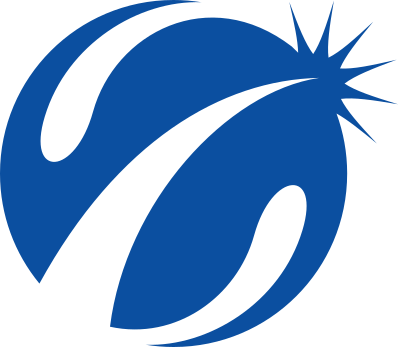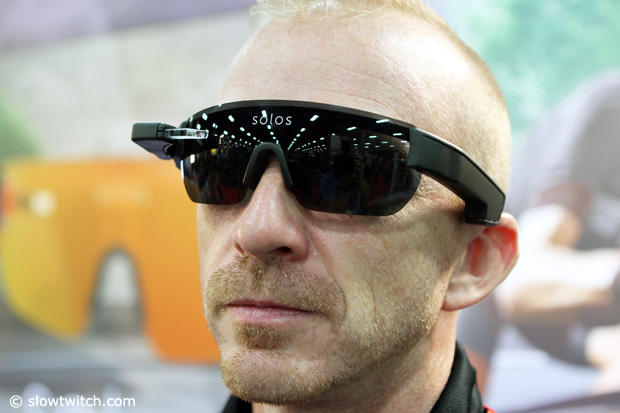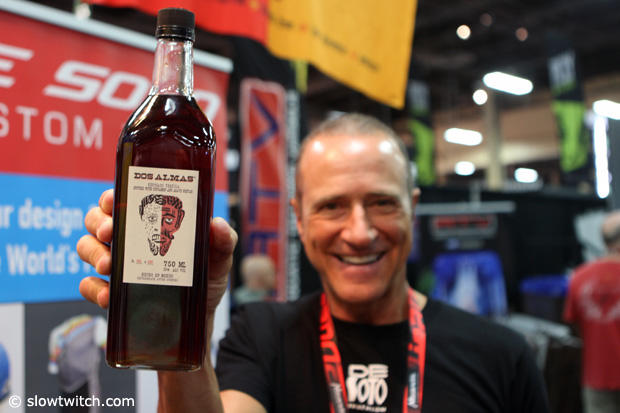The Envelope Please
The best in class in commercial categories were honored the TBI (Triathlon Business Intl) conference in Marina del Rey, California, this past Monday night.
The big winner was Norway. If they couldn't before the conference, triathlon's business interests can find Scandinavia on the map now. Norseman's Dag Oliver was on the stage often, picking up awards for Bucket List Triathlon (Norseman), best long video (Norseman), and accepting best short video on behalf of Rockman, a swim-run event staged in Norway.
Dag (pronounced more like him who is the Bounty Hunter than Dag Nabbit) also spoke at the conference, addressing a crowd in the main ballroom immediately following a presentation by Strava's David Lorsch. Dag fielded questions afterward, including one by Ironman's Andrew Messick, who noted that Norseman is propelled by the same spirit that energized John and Judy Collins in Ironman's earliest days. What flummoxes many in the business community is that Norseman is run more like a proof-of-concept project than a show-me-the-money project. Norseman's goal, as expressed by Dag, is to produce and partner with events that adhere to its values of “True, Basic and Unique.”
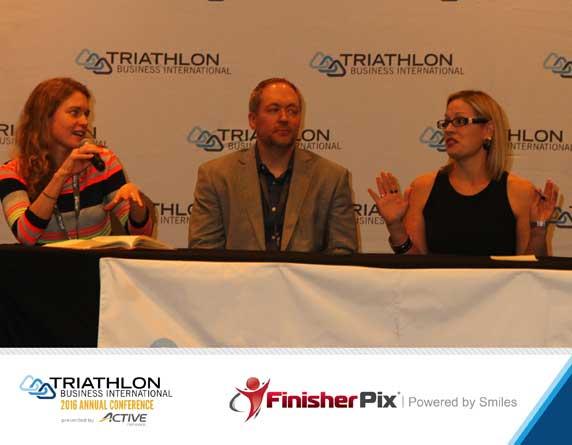
Money as an afterthought, and an eventual cash-out not even on the radar of the Norseman folks, reminded many in attendance why they got into this business. This counterintuitive approach has produced events only equaled in popular imagination by Ironman, Challenge Roth and Escape from Alcatraz.
High-powered Women
The awards were nested inside a conference, which was opened with a keynote address by U.S. Congresswoman (and Ironman competitor, and Slowtwitcher) Kyrsten Sinema (AZ), entitled Can't Swim and I'm Afraid of the Bike. Triathlon remains in tension, pulled by its status as an aspirational sport and its isolation as both a physically and financially out-of-reach sport (for many). Ironman in North America is 30-something percent female, while half-marathons can be 70-percent female, marathon's as high as 60-percent. Yet marathons were once considered out-of-reach by women.
Following Congresswoman Sinema's speech was a panel discussion on the topic. Professional triathlete and TriEqual's president Sara Gross is pictured above, on the left, Congresswoman Sinema is on the right. USA Triathlon's Chuck Menke is flanked by these two high-powered women, handling it more bravely than I would have.
Ron Smith
Back to awards, the Ron Smith Award has so-far been won by a pro athlete, always by a figure who's gone above and beyond the call of duty. This year Bob Babbitt outpolled the pros who were nominated and if anyone in triathlon has gone above and beyond, it's Bob. He has been triathlon's premier evangelist for a generation. He has also been the prime mover in an organization that has raised $70 million and counting to help Challenged Athletes achieve their dreams.

Steve Hed
This year a new award debuted, to honor the person whose creative talent has resulted in a product or service making the biggest difference in the lives of triathletes. I have been told this was not even a close vote. Jon Mayfield, who first conceived of and remains the brainchild of Zwift, is the recipient of the Steve Hed Award. The award itself is a small reproduction of a HED3 wheel. Award designer Dan Ashworth (look on your mantle, if you have awards they're probably from Ashworth), had no input or direction. The idea, concept and execution was all his.
Top Retailers
Seattle's Speedy Reedy was America's top retail establishment catering to triathletes in 2015. Second was Nytro Multisport and third was Moment Cyclesport. This means two of the top-3 stores in the U.S. were just miles apart in San Diego, the birthplace of triathlon. San Diego is not a major triathlon market the way Los Angeles, Chicago, Houston and New York are. That such great shops remain in San Diego is legacy of triathlon's roots.
In the retail awards, the winners win because of a score generated by votes and ratings from end-users and vendors. Notwithstanding the recognition, two shops in the top-10 in the voting of this award over the last 3 years are not in existence today, and a top-10 store on this 2015 list faces possible imminent closure. This shows the perilous state of triathlon retailing.
Other Award Winners
Best Triathlon Published Article and Image in 2015:
– (Photo) Shot at 2015 Challenge Roth by Paul Phillips, Competitive Image, and published in triathlon.competitor.com
– (Article) “Iron in the Fire” by Brad Culp, published in LAVA magazine
Best Events of 2015
– Large event (1,000+) = Ironman World Championship, Kailua-Kona, HI
– Small event (less than 1,000) = Musselman, Geneva, NY
– Bucketlist = Isklar Norseman Xtreme Triathlon
Industry Themes
This conference is not simply the place where honors are bestowed, but where education and discussion takes place. As is usual, the prime benefit of this conference is in networking. As a personal aside Slowtwitch typically does more fruitful business here even than at Interbike, Kona, or any other gathering where networking is the goal, because of rather than in spite of this industry gathering numbering just a few hundred rather than tends of thousands. What you see in the image below is speed networking, which is a TBI Conference staple and sets the tone for the conference.
I intended to leave the conference at 10am Tuesday, but did not leave until 2pm because of a flurry of ad hoc serendipitous 15-minute meetings and deals as I attempted to negotiate the final 150 feet from the ballroom to the front exit door.
Two first-time attendees told me the same thing. John Cobb and Greg Bennett each said, “I don't know why I haven't been here each of the last 5 years.” Greg said he thought every pro athlete ought to attend this conference for each athlete's own as well as the industry's good. He whimsically said he thought such attendance should be mandatory and while he was hyperbolic in his exhortation I that I think this captures his sense of the importance of an annual industry gathering with pro athletes as equal industry partners.
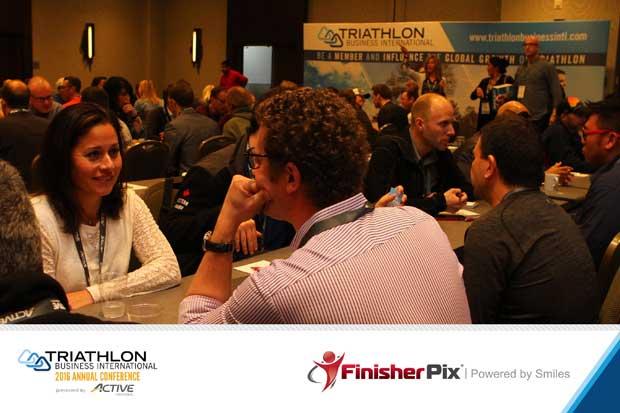
As another aside, I have also attended each of Interbike's first two award and banquet ceremonies, and a lot of athlete awards are presented: best in mountain bike, triathlon, road cycling. If memory serves only one athlete among all who won Interbike awards personally accepted his or her award. Conversely, industry winners (manufacturers, retail stores) all accepted their awards personally. Almost all athletes who won, “regret not being here to accept the honor personally.”
Stand back and look at this picture in landscape. Increasingly, and especially in bike racing, the money funding teams and athletes is coming from endemic sources. There are fewer Mapeis, Rabobanks and T Mobiles. Who have stepped into the breach? Cannondale, Giant, Specialized, Trek. So, to a cyclist, the entity writing your team's largest checks is more likely than not going to be in this room (even if it is not exhibiting at Interbike), sitting around these tables. Further, the customers the retailers) paying those who're funding said team are sitting around other tables in the same room at the same time.
What is it these athletes are doing in mid-September that is more important than accepting their awards in person? In some cases, racing. Gwen Jorgensen was winning the ITU Grand Final in Chicago instead of accepting her Interbike award. But the year before she wasn't. so she was at Interbike, standing in solidarity with her sponsors.
Amateur Club-Teams
John Cobb, seller of Cobb saddles, Matt Miller of BASE Performance, and Andy Potts (AP Racing) sat on a panel I moderated on the amateur club-team phenomenon. These teams are proliferating. Wattie Ink is such a team, broadly speaking. Everyman Jack, QT2, Chris McDonald's Big Sexy, and many others are one form or another. I asked for a show of hands, between a quarter and a third of those attending this session have their own club-teams.
These teams perform different functions depending on whether the organizer is a manufacturer, coaching org, media entity, or pro athlete. Andy Potts is a fairly prolific blogger, and AP Racing is a way to formalize and deliver his message. His coach, Mike Doane, may be less recognized as a triathlon coach only because he's quite well known as a swim coach. AP Racing is a chance for Andy to leverage his and his coach's knowledge and knowhow.
As John Cobb explains it, Cobb Mobb was a way to redirect money he has been paying to pro athletes into a project that delivers a stronger dividend. Repurposing this money not only got a bigger bang for his buck – he feels – he “had more fun at the races” because he actually saw the fruit of his efforts in the form of athletes at the races he attends (he rarely saw his own sponsored pros at his own race expo booth).
Greg Bennett spoke at the conference and said that of the 600 or so card-holding elites in the U.S. maybe 12 are truly professional. This kind of thing has been said many times. It always stings. But when you marry Greg's statement with John's explanation for Cobb Mobb, there is a common thread.
Omni-Channel
This is the most cogent discussion going on right now in commerce, at least in sporting goods commerce. It was the theme of another TBI Conference session. What is a manufacturer's online strategy? Are there new kinds of retail enterprises that survive and even thrive – are even built around – the notion that manufacturers might explore alternate ways of getting its products into a consumer's hands? Are the amateur club-teams referenced above, and are coaches, viable and proper sales channels? Does omni-channel hurt retailers or help retailers?
After 5 years in Southern California the TBI Conference will move to Dallas, Texas for its January, 2016 edition.

